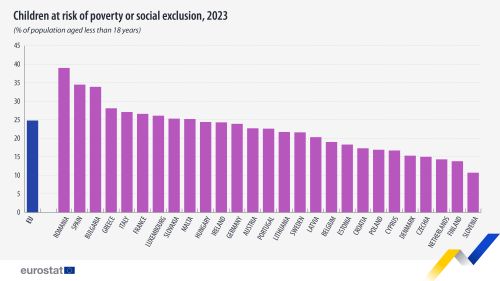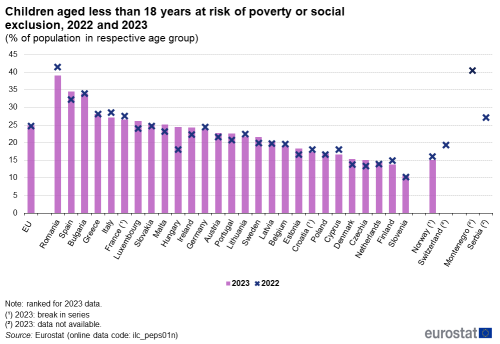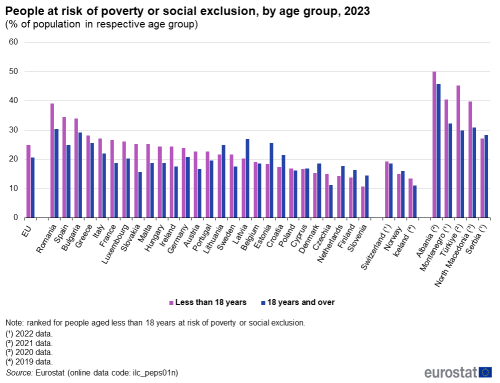Data extracted in 19 June 2024.
Planned article update: 30 May 2025.
Highlights
Between 2022 and 2023, the percentage of children at risk of poverty or social exclusion in the EU remained relatively stable.
In 2023, 24.8% of children aged less than 18 in the EU were at risk of poverty or social exclusion compared with 20.6% of adults (aged 18 and more).
In 2023, in the EU, 10.7% of children aged less than 18 whose parents’ level of education was high were at risk of poverty or social exclusion, compared with 61.8% of children whose parents’ level of education was low.

Children at risk of poverty or social exclusion, 2023
(% of population aged less than 18 years)
Source: Eurostat (ilc_peps01n)
This article presents statistical data on the situation of children (aged less than 18 years) in the European Union (EU) who were at risk of poverty or social exclusion (AROPE) in 2023. The analysis compares children with adults (aged 18 years and over) and displays the impact of the parents’ educational attainment on the children AROPE levels.
Key findings
The percentage of people who are at risk of poverty or social exclusion encompasses people who are in at least one of these three situations:
- people who are at risk of poverty: those with an equivalised disposable income that is below the at-risk-of-poverty threshold;
- people who suffer from severe material and social deprivation: those who cannot afford at least seven out of thirteen deprivation items (six related to the individual and seven related to the household) that are considered by most people to be desirable or even necessary to lead an adequate quality of life;
- people (aged less than 65 years) living in a household with very low work intensity: those living in households where adults worked equal to or less than 20 % of their total combined work-time potential during the previous twelve months.
- In 2023, 24.8 % of children (aged less than 18 years) in the EU were at risk of poverty or social exclusion, compared to 20.6 % of adults (aged 18 years and over).
- Data indicate that the higher the educational attainment level of parents, the lower the proportion of children at risk of poverty or social exclusion:
- 61.8 % of children whose parents had a low level of education were at risk.
- 10.7 % for children whose parents had a high level of education were at risk.
Children at risk of poverty or social exclusion
In 2023, the proportion of children at risk of poverty or social exclusion in the EU was 24.8 %. At national level, the highest rates were observed in Romania (39.0 %), Spain (34.5 %) and Bulgaria (33.9 %). On the other side, the lowest rates were recorded in Slovenia (10.7 %), Finland (13.8 %) and the Netherlands (14.3 %). The percentage of children at risk of poverty or social exclusion remained relatively stable between 2022 and 2023
At the EU level, between 2022 and 2023, the percentage of children at risk of poverty or social exclusion went from 24.7 % to 24.8 % (Figure 1).
At the national level, Hungary recorded the largest rise, up by 6.3 percentage points (pp), followed by Spain (+2.3 pp), and both Luxembourg and Malta (+2.1 pp each). In contrast, decreases were observed in Romania (-2.5 pp), Cyprus and Italy (both -1.4 pp), and Finland (-1.1 pp). Bulgaria and Greece reported stable figures.

(% of population in respective age group)
Source: Eurostat (ilc_peps01n)
In 2023, the risk of poverty or social exclusion was higher for children than for adults
In 2023, children aged less than 18 in the EU were at a higher risk of poverty or social exclusion (24.8 %) compared to adults aged 18 and over (20.6 %), resulting in a difference of 4.2 pp (Figure 2). Eighteen EU countries presented a similar situation, with the largest differences recorded in Slovakia and Spain (9.6 pp for each), Romania (8.6 pp) and France (7.8 pp). Among the countries where adults faced a higher risk of poverty or social exclusion than children, the largest differences were observed in Estonia, Latvia and Croatia, with adults exceeding children’s risk by 7.3, 6.6 and 4.1 pp, respectively.

(% of population in respective age group)
Source: Eurostat (ilc_peps01n)
In 2023, children whose parents attained a higher education level were less likely to be at risk of poverty or social exclusion
In 2023, 61.8 % of children in the EU living with parents who had at most lower secondary education (ISCED levels 0-2) were at risk of poverty or social exclusion. For those with parents who attained tertiary education (ISCED levels 5-8), the proportion was 10.7 % (Figure 3). This resulted in a risk gap of 51.1 percentage points (pp) based on parents' education levels.
At the national level, the gap was above 50.0 pp in 15 countries. It ranged from 21.9 pp in Poland, 35.8 pp in Malta and 36.6 pp in Lithuania to 72.5 pp in Hungary, 73.5 pp in Romania and 74.9 pp in Bulgaria

(%)
Source: Eurostat (ilc_peps60n)
Source data for tables and graphs
Data sources
The data used in this article are derived from the EU Statistics on income and living conditions (EU-SILC). EU-SILC data are compiled annually and are the main source of statistics that measure income and living conditions in Europe; it is also the main source of information used to link different aspects relating to the quality of life of households and individuals.
The reference population for the information presented in this article is all private households and their current members residing in the territory of an EU Member State (or non-member country) at the time of data collection; persons living in collective households and in institutions are excluded from the target population. The data for the EU are population-weighted averages of national data. The reference period for individuals' characteristics is 2023. The data is available for the 27 Member States as well as Norway, Switzerland, Iceland and Serbia, Montenegro, North Macedonia, Albania and Türkiye. At-risk-of-poverty or social exclusion rate (AROPE) is the headline indicator to monitor the European Pillar of Social Rights Action Plan (EU 2030 targets) poverty target. It reflects the share of the population which is either at risk of poverty, and/or severely materially and socially deprived and/or lives in a household with very low work intensity.
Educational attainment level is classified according to ISCED — the international standard classification of education. The (latest) 2011 version defines the following levels:
- ISCED level 0 — early childhood education;
- ISCED level 1 — primary education;
- ISCED level 2 — lower secondary education;
- ISCED level 3 — (upper) secondary education;
- ISCED level 4 — post-secondary non-tertiary education;
- ISCED level 5 — short-cycle tertiary education;
- ISCED level 6 — bachelor’s or equivalent level;
- ISCED level 7 — master’s or equivalent level;
- ISCED level 8 — doctoral or equivalent level.
The analysis presented in this article focuses on the following aggregations of ISCED levels:
- ISCED levels 0-2: less than primary, primary and lower secondary education;
- ISCED levels 5-8: tertiary education
Explore further
Other articles
Database
Thematic section
Selected datasets
Methodology
External links
Legislation
- Detailed list of legislative information on EU-SILC provisions for survey design, survey characteristics, data transmission and ad-hoc modules
- Regulation (EC) No 2019/1700 — — the central piece of legislation for social surveys including EU-SILC
- Regulation (EC) No 2019/2242 — — additional central piece of legislation for EU-SILC
